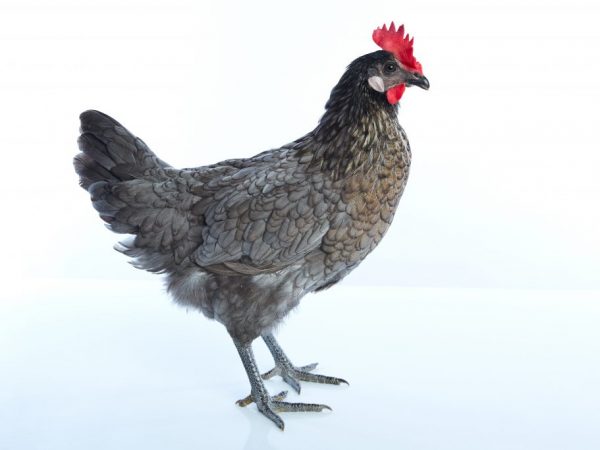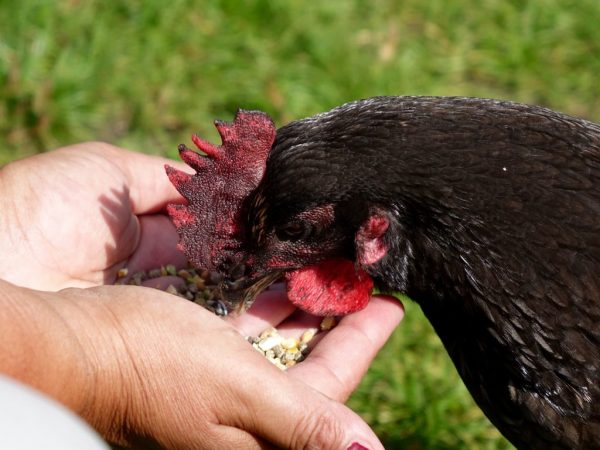Breeding and keeping of Andalusian blue chickens
The Spanish Andalusian blue breed of chickens was developed in the 19th century. Breeders managed to get this breed by crossing white and black Minorcs with a blue fighting cock. The result of the development is birds with good egg production, beautiful, original color and passionate disposition.

Breeding and keeping of Andalusian blue chickens
Characteristics of the breed
The description of Andalusian chickens includes several distinctive qualities:
- the bird has a slender constitution, the weight of the laying hen is about 2 kg, the rooster is 2.5-2.7 kg;
- earlobes are elongated, white with a smooth surface;
- the face is reddish;
- eyes are round, brown;
- light-colored skin, almost snow-white;
- the surface of the paws is light yellow with a blue tint;
- small, bluish beak;
- the crest is leaf-shaped, in chickens it is lowered to the face, in roosters it is erect.
The neck and trunk are elongated, the chest is of medium width. In males, the tail is at an angle of 90 ° in relation to the skeleton.
The belly and chest area has a lighter plumage than the back and mane. The feathers are unusual - steel blue with dark edging.
Where could I buy
You can buy hatching eggs, young or adult chickens at several poultry farms in Russia - Kurkurovo, Veselaya Ryaba, Bird Village.
The cost of seven-day-old chicks is 300 rubles, of two-week-old chicks - 350 rubles. The price for one hatching egg is 200 rubles.
Crossing features
Very often you have to observe a picture when from the entire brood, only 50% of the offspring are obtained with blue plumage, the second half with white or resinous color.
The change in tone is influenced by genetics. This breed has two genotypes - black and blue. Therefore, when crossing birds with different colors, chickens can turn out to be diverse:
- some of the chicks (about 50%) will carry a combination of 2 genes;
- a little over 15% will be obtained with black plumage;
- a quarter are blue individuals with light blotches, which are also called splash.
When crossing the last two, the probability of getting young animals with a rich blue color is almost 100%
Temper
Andalusian chickens have not only beautiful and unusual coloring, but also a cocky character, similar to the Spanish.
In the absence of a threat, they behave calmly; in the event of a stranger, they begin to show aggression.
In such situations, the rooster dominates the chickens and acts as the protector of the entire livestock. In order to avoid commotion in the hen house, they must be properly planted and the procedure for completing the family must be carefully approached. Since any stress can negatively affect the productivity of layers.
Birds of this breed are distinguished by their leisurely nature, they easily make contact with humans.
Performance

Chicken does not differ in performance from other breeds
Growth and development in this breed is exactly the same as in other varieties.
The first egg production begins at the age of 6 months. In a year, one chicken can lay up to 180 eggs, some more - up to 200 eggs. But this rarely happens.
All one egg varies from 50 to 60 g. The surface is white, firm.
You should not breed this breed just for the sake of obtaining meat, because chickens are not overweight compared to broilers. The most valuable is the meat of young individuals - it tastes tender and there is practically no fat in it.
Life expectancy is 9-10 years, but a decrease in egg production can be observed as early as 4 or 5 years of breeding.
Laying hens can be kept until they die, but as they age, they become increasingly ill and their performance drops significantly. Therefore, experienced breeders recommend replacing every four years.
Advantages and disadvantages
The description of this breed includes several advantages:
- high decorative qualities;
- relatively good egg production;
- good survival rate in chicks is about 93%, in adults - 87%;
- great taste of meat and eggs.
It has several disadvantages:
- the desire to incubate chickens and further maternal instinct are poorly developed, therefore incubators are often used for breeding poultry;
- deformation of the ridge, which leads to a loss of decorative appearance;
- the breed is very rare and expensive - a weekly chick costs about 300, a two-week old 350, a hatching egg - 200 rubles;
- afraid of cold and sudden changes in temperature.
Content rules
Poultry house
Keep birds in a dry, spacious and warm room with good ventilation and no drafts. The calculation of the place is carried out as follows - at least 1 m² is allocated for 2-3 individuals.
If the area is smaller, the risk of developing diseases and parasites is high. At a lower density, they will freeze in the chicken coop.
The bottom of the floor is covered with sheets of tin to exclude the possibility of rodent penetration. Then it is whitewashed with slaked lime to prevent the appearance of fungal infections. A thick layer of straw, dry peat or large sawdust is laid on top.
The laying of the flooring is carried out in dry and sunny weather, otherwise it will be saturated with dampness and can quickly become moldy. Change the litter no more than once a year.
Chicken droppings and feathers that fall on the floor help maintain the desired indoor humidity.
To eliminate the risk of injury, adults are not set too high perches - up to 50 cm from the floor surface.
Ventilation and illumination
It is important to provide good lighting for 12-13 hours a day. The illumination should not be too bright or dim. Diffused daylight, which can be created by using lamps, is suitable.
The second important condition is good ventilation. Every day, the room is ventilated by opening a window, door or cover, depending on the type of construction.
In the absence of air exchange, there is a high risk of developing pathogenic bacteria and microbes in a musty chicken coop.
The optimal temperature regime for keeping chickens is about 25 ° C. There should be no drafts that contribute to sudden temperature changes and cause colds in birds.
Place for walking

The chicken is kept in a confined space
The description of the Andalusian blue breed of chickens includes good productivity provided they are daily walked. Therefore, you need to take care of a place for walking chickens and roosters in advance.
The walking area is fenced off with a high fence and a net is pulled from above, since this bird is capable of flying high. The soil is sown with grass of cereal crops in order to provide chickens with green fodder for the summer period in the future.
Due to increased aggression and temperament, it is not recommended to keep it together with other breeds. Frequent fighting can injure and reduce the productivity of both varieties.
Feeding ration
In the chicken coop, it is necessary to install feeders and drinkers that are convenient and accessible for each individual.This breed has a good appetite and readily eats any food. The diet includes:
- grain crops;
- weeds;
- industrial compound feed;
- leftover food from the table;
- wet mash, cooked in fish or meat broth with the addition of vegetables and cereals, are served warm.
In the summer, the amount of greenery is increased, reducing the rate of grain and other feeds for the winter diet. To increase egg production in the off-season, hens are given sprouted wheat, barley, rye. This food contains many vitamins and minerals. Additionally, layers are given gravel, shellfish, sunflower cake, legumes, fish and meat and bone meal.
You need to change the water in the drinkers every day, especially if it is a simple container with an open top. It must be fresh and clean.
For convenience, many breeders use nipple or groove designs, in which the liquid remains high quality longer.
Breeding nuances
Breeding in a chicken coop is very rare, so breeders use incubators.
An important condition for the successful hatching of chicks is a selection of quality eggs. Select only fresh (not older than 5 days) without cracks, with a flat and smooth surface. It is better to use medium sized specimens.
Fertilization of eggs is quite high - about 95%. After laying and until the brood appears, a certain regime is maintained in the incubator - in the first 7 days, 40 ° С, all subsequent weeks are reduced by 1 ° С. During incubation, the eggs are turned daily 3-4 times a day.
The hatched chicks are kept in a dry box at a temperature of 25 ° C with diffused daylight.
Feeding young animals
Feeding begins after the cannon dries up when the chicks become active. The first dish is a boiled and chopped chicken egg.
From the third day of life, they are fed with cottage cheese, small herbs and cereals. Young individuals eat often, so they need to be fed at least five times a day.
Up to three weeks of age, chicks need a large amount of protein, which strengthens bone tissue and prevents the development of rickets - minerals, dairy products, fish oil, yeast are introduced into the diet. Additionally, coarse-grained, pre-calcined sand is produced.
To strengthen immunity and increase activity, instead of water, they give glucose (5%) for the first 3 days. All subsequent days offer clean, fresh water at room temperature.
Care features
The main care of chicks is to ensure a stable temperature regime within 25-27 ° C, good illumination for at least 10 hours a day.
Sawdust or straw is used as flooring in the box, which is changed every five days. On sunny days, they can be walked in the fresh air.
Starting from 2 weeks, chickens are transferred to the diet of an adult - they are given chopped feed. From the age of two months, young animals begin to be kept in a common herd.
Diseases
The Andalusian breed of chickens has good immunity against diseases, only if the conditions of detention are violated in high humidity, dampness and cold they get cold.
To maintain the health of adults and young individuals, it is necessary to maintain these indicators at the required level. Young animals are vaccinated at an early age.
During the molt period, avitaminosis develops in birds, so the diet should be especially rich and balanced.
Breeders' opinion
Breeders of this breed leave positive reviews:
- many take this bird because of its unusual color and high decorativeness;
- others are satisfied with its good egg production and excellent taste of meat and eggs;
- for novice poultry farmers, experienced farmers recommend buying grown-up young animals with a high survival rate.


